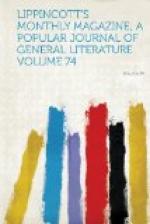Moral: Don’t duel.
THE DOG AND THE SPARE-RIB. A mastiff crossing a bridge, and bearing in his mouth a piece of meat, suddenly swallowed the meat. He immediately observed that the shadow of the aforesaid meat in the water had disappeared.
Such is optics.
Moral: We learn from this fable that life is but a shadow.
THE ASS AND THE LOCOMOTIVE. A donkey one day was quietly munching thistles when he heard the screaming whistle of a locomotive. Pricking up his ears, he started into a gallop and raced across lots with his tail high in the air.
Moral: This fable teaches what an ass he was.
THE MOUSE AND THE CAT. A mouse once peeped from his hole and saw a cat. The cat was looking the other way, and happened not to see the mouse.
Nobody killed.
Moral: This little fable doesn’t teach anything.
SARSFIELD YOUNG.
A PICTURE WITH A HISTORY
In a number of Punch for February, 1873, in the account of “Our Representative Man’s” visit to the Exhibition of Old Masters, occurs the following sentence: “No 35. Oh, Miss Linley (afterward Mrs. Sheridan), oh how lovely you are! Oh, Thomas Gainsborough, oh, Thomas Gainsborough, oh! And if Baron Lionel de Rothschild, M.P., ever wishes to offer a testimonial to one who knows nothing whatever about him, and for no particular object, let him send this picture, carriage paid, to the residence of your representative, who as his petitioner will never cease to pray at convenient seasons, etc.”
The picture thus apostrophized represents that “Saint Cecilia, the beautiful mother of a beautiful race, [3] whose delicate features, lighted up by love and music, art (Reynolds’s and Gainsborough’s) has rescued from the common decay.”
It is not unlikely that Sheridan or his wife may have presented this picture to the Hon. Edward Bouverie.[4] A letter of Mrs. Sheridan in 1785 (she died in 1792) is dated from his seat, Delapre Abbey, and she and Sheridan were habitues of his house.
It was at the death of General Bouverie, grandson of Mrs. Sheridan’s friend, that her picture was sold, a few months ago, to Baron Rothschild; and a romance might well be woven out of the circumstances which caused this painting to be removed from the place which it had so long occupied in the library of Delapre Abbey.
Delapre Abbey is a stately mansion occupying ground once covered by a monastery, of which the only remains serve as offices of the more modern edifice. Approaching the ancient borough of Northampton by the old London road, you observe on your left, about a mile from the town, a beautiful specimen—one of the only three remaining—of the crosses which a king of England raised to commemorate the places where his beloved wife’s body rested on her last journey to Westminster. It lay one night at the abbey, and, whilst that is almost obliterated, the cross remains almost perfect after centuries have elapsed, and served mainly as the model for that which has recently been erected close to Charing Cross, where formerly another of these memorials marked the last halt of the royal funereal cortege.




